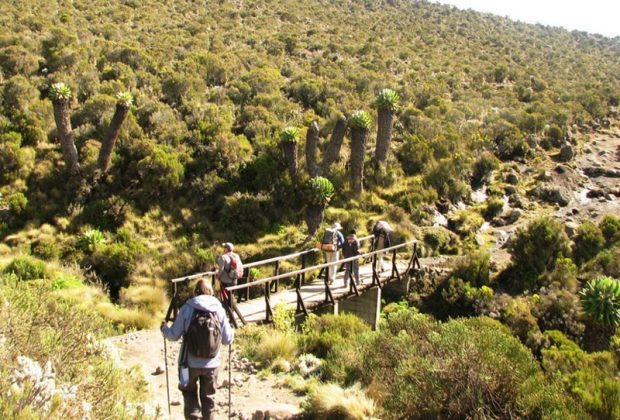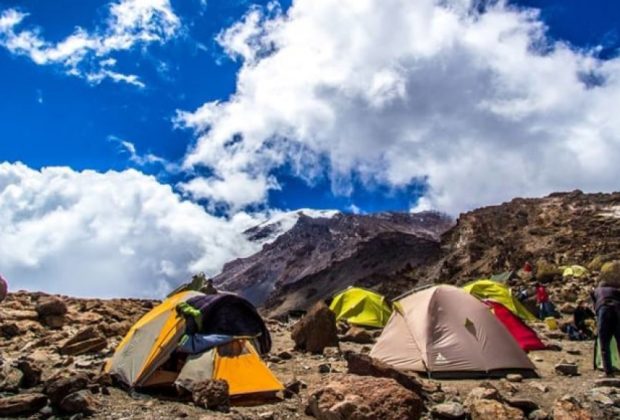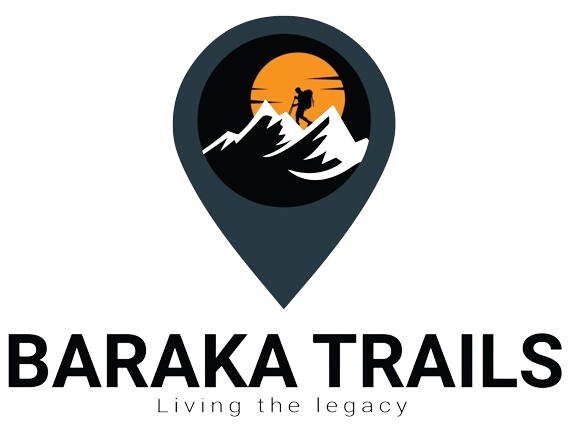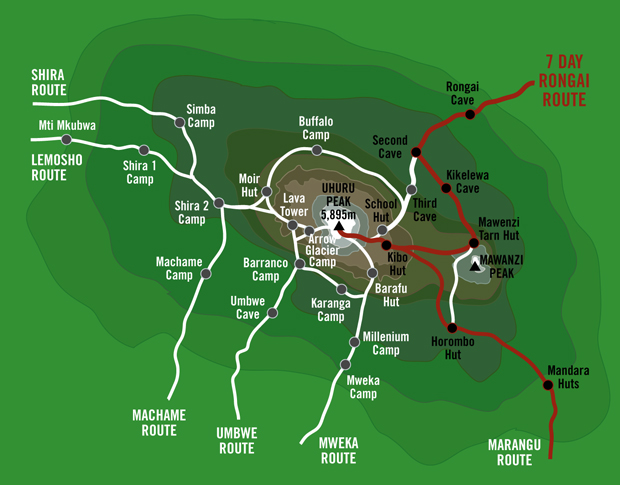7 Days Rongai Route



The Rongai Route is one of the easiest routes and the success rate is very high.
The route starts on the north side of the mountain just south of the Kenyan border, and is one of the least traveled routes. The descent is down the Marangu Route on the south side of the mountain, so climbers see the mountain from many view points.
The drive to the trail head takes about 3 hours from Moshi through many villages and coffee plantations, including a stop to register climbing permits at Marangu.
The Rongai Route can also be accessed from Amboseli National Park in Kenya. Allow 2 hours including border crossing. We will need copies of passports ahead of time.
Day 1: Moshi/ Arusha to Simba Camp
Drive to the attractive wooden village of Nale Moru. After signing in and preparing the porters, you will begin the hike on a wide path that winds through fields of maize and potatoes before entering pine forest. The track then starts to climb consistently but gently through attractive forest that shelters a variety of wildlife. The forest begins to thin out and the first camp is at the edge of the moorland zone with extensive views over the Kenyan plains.
Elevation: 2000m/6560ft to 2650m/8700ft
Distance: 6km/4mi
Hiking Time: 3-4 hours
Habitat: Montane Forest
Meals: Lunch and Dinner
Day 2: Simba Camp 2650m to Second Cave 3450m
The morning hike is a steady ascent up to the Second Cave with superb views of Kibo and the Eastern ice fields on the crater rim.
Elevation: 2650m/8700ft to 3450m/11,300ft
Distance: 6km/4mi
Walking Time: 3-4 hours
Habitat: Moorland
Meals: Breakfast, Lunch and Dinner
Day 3: Second Cave 3450m to Kikelewa Camp 3600m
Head out across the moorland on a smaller path towards the jagged peaks of Mawenzi. The campsite is in a sheltered valley with giant Senecios nearby.
Elevation: 3450m/11,300ft to 3600m/11,800ft
Distance: 9km/5mi
Walking Time: 2-3 hours
Habitat: Semi-desert
Meals: Breakfast, Lunch and Dinner
Day 4: Kikelewa Camp 3600m to Mawenzi Tarn 4330m
A short but steep climb up grassy slopes is rewarded by superb views. Leave the vegetation behind shortly before reaching the next camp at Mawenzi Tarn, spectacularly situated in a cirque directly beneath the towering spires of Mawenzi. The afternoon will be free to rest or explore the surrounding area as an aid to acclimatization.
Elevation: 3600m/11,800ft to 4330m/14,200ft
Distance: 6km/4mi
Walking Time: 3-4 hours
Habitat: Semi-desert
Meals: Breakfast, Lunch and Dinner
Day 5: Mawenzi Tarn 4330m to Kibo Hut 4750m
Cross the lunar desert of the ‘Saddle’ between Mawenzi and Kibo to reach Kibo campsite at the bottom of the Kibo crater wall. The remainder of the day is spent resting in preparation for the final ascent very early.
Elevation: 4330m/14,200ft to 4750m/15,600ft
Distance: 9km/5mi
Hiking Time: 4-5 hours
Habitat: Alpine Desert
Meals: Breakfast, Lunch and Dinner
Day 6: Kibo Hut 4700m to Summit 5895m to Horombo Hut 3700m
Very early in the morning (midnight to 2am), commence the climb to the summit on steep and heavy scree or snow up to Gilman’s Point located on the crater rim (elev 5700m/18,700ft). Continuing, we now ascend to Uhuru Peak, which is the highest point in Africa. There are unbelievable views at every turn. Have your picture taken at the summit to show your friends and family. From here we descend, stopping for lunch and a rest at Kibo before continuing on to the Horombo encampment.
The beginning of this climb is done in the dark and requires headlamps or flashlights. It will be very cold until you start descending, so you will need all of your warm layers. This is by far the most difficult part of the trek with many switchbacks. Going slowly “pole pole” and an optimistic attitude will get you there!
Elevation: 4700m/15,500ft to 5895m/19,340ft
Down to 3700m/12,200ft
Distance: 6km/4mi up / 15km/9mi down
Hiking Time: 6-8 hours up / 6-8 hours down
Habitat: Alpine Desert
Meals: Breakfast, Lunch and Dinner
Day 7: Horombo Hut to trail head to Arusha hotel
After breakfast, a steady descent takes us down through moorland to the Mandara Hut. Continue descending through lush forest path to the National Park gate at Marangu. At lower elevations, it can be wet and muddy. Gaiters and trekking poles will help. Shorts and t-shirts will probably be plenty to wear (keep rain gear and warmer clothing handy).
RONGAI 7 DAYS ROUTE PACKAGE INCLUDE
- Private pick up and drop off at Kilimanjaro international airport.
- Accommodation in Moshi/ Arusha, 1 nights before and 1 after the trek (Hotel is Bed & Breakfast basis)
- Park fees, camping fees & rescue fees $20/climber
- 18% VAT on tour fees & services
- 4 Season big sleeping mountain tents
- Double layered Sleeping Mats
- Transportation to & from the mountain gate
- Professional mountain guides, cooks and porters
- 3 meals daily while on the mountain
- Filtered water throughout the trek
- Fair wages for the mountain crew as approved by the Kilimanjaro National Park Authority (KINAPA), Kilimanjaro Association of Tour Operators (KIATO)
- Private Portable toilets and toilets tents (option).
- Hot Water For Wash everyday at any time at the camp
NOT INCLUDED
- International and local flights
- Items of a personal nature (gears can be rented in Arusha)
- Laundry Services (Optional)
- Tips to mountain crew for 7 days trip.
What is Mount Kilimanjaro?
- Mount Kilimanjaro is the highest peak in Africa, located in Tanzania. It is a dormant volcano and one of the most iconic mountains in the world.
How tall is Mount Kilimanjaro?
- The summit of Mount Kilimanjaro, called Uhuru Peak, stands at an elevation of 5,895 meters (19,341 feet) above sea level.
How long does it take to climb Mount Kilimanjaro?
- The duration of a Kilimanjaro climb varies depending on the route chosen. Most climbs typically range from 5 to 9 days.
What are the different routes up Mount Kilimanjaro?
- There are several routes to the summit of Kilimanjaro, each with its own characteristics and scenery. Popular routes include the Marangu, Machame, Lemosho, Rongai, and Northern Circuit routes.
Is climbing Mount Kilimanjaro difficult?
- Climbing Kilimanjaro is challenging due to its high altitude, but it doesn’t require technical climbing skills. However, climbers should be physically fit and prepared for the rigors of high-altitude trekking.
Do I need a guide to climb Mount Kilimanjaro?
- Yes, it is mandatory to have a registered guide accompany you on your Kilimanjaro climb. Guides are essential for safety, navigation, and providing support throughout the trek.
When is the best time to climb Mount Kilimanjaro?
- The best times for climbing Kilimanjaro are during the dry seasons, which are typically from late June to October and from December to March. These months offer clearer skies and better trekking conditions.
What should I pack for climbing Mount Kilimanjaro?
- Essential items for climbing Kilimanjaro include proper clothing for varying temperatures, sturdy hiking boots, a good quality sleeping bag, trekking poles, personal medications, and other necessary gear as recommended by your tour operator.
What are the risks of climbing Mount Kilimanjaro?
- The main risks of climbing Kilimanjaro include altitude sickness, which can affect anyone regardless of fitness level, as well as other potential hazards such as extreme weather conditions and physical exhaustion.
Do I need to train before climbing Mount Kilimanjaro?
- Yes, it is highly recommended to undergo physical training and preparation before attempting to climb Kilimanjaro. This can include cardiovascular exercises, strength training, and hiking to build endurance and fitness levels.
Per Person $2,450
GROUP $2,250

